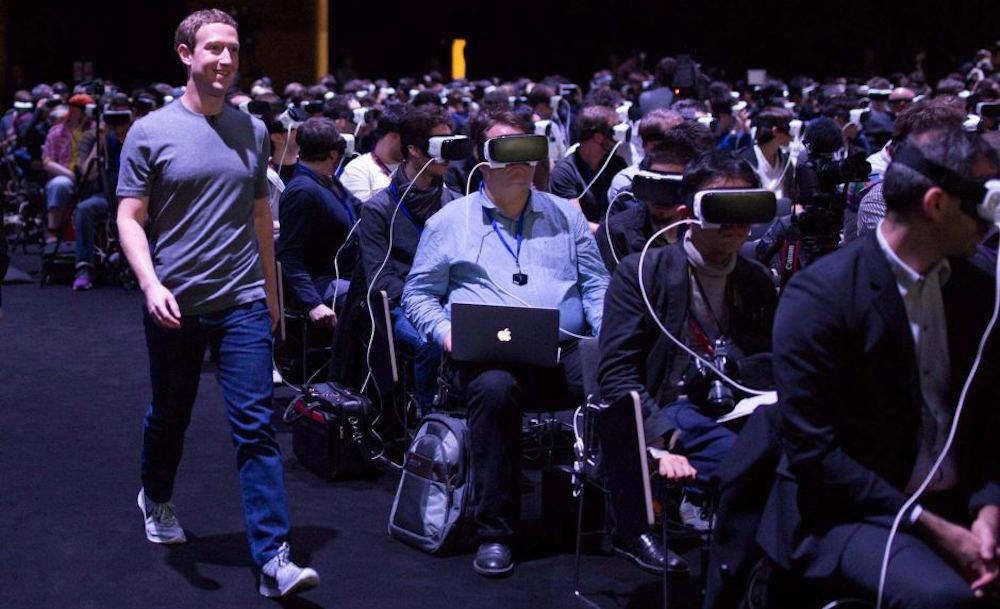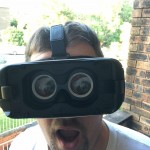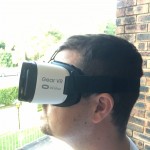
Samsung’s Gear VR has gone through three iterations before reaching a review bench at Ausdroid. The first iteration — the original Gear VR — was kind of limited, and only worked with the Samsung Galaxy Note 4. An Innovator Edition was launched last year, which worked with the Galaxy S6 / Galaxy S6 Edge, but still it wasn’t all that enticing.
No, it was the third generation that finally caught our eyes, and in quite a stunning way. You see, the Gear VR was used to great effect during Samsung’s Mobile World Congress event this year, where more than 4,000 people simultaneously experienced a VR journey to go alongside the launch.
It was quite something.
Why? The Gear VR converts a range of Samsung’s latest Galaxy smartphones into a full-on mobile virtual reality headset; you don’t need to hold it up like Google Cardboard (it has straps) and it’s incredibly smooth, so much so that it’s easy to get lost in the experience.
With the number of VR devices launching this year in Australia set to increase, we thought it was high-time we took a closer look. Samsung’s Gear VR is similar to Google Cardboard (and LG’s VR 360 kind of) in that it relies on a smartphone to make it work. There are other devices, like Oculus Rift and HTC’s Vive, which require tethering to a PC, but the Gear VR is very much a smartphone-powered device. Like Google Cardboard, and unlike LG’s 360 VR, the Gear VR requires the insertion of a compatible smartphone to make it work, otherwise it’s little more than a collection of plastic, material and some wiring. The need to include a phone in the headset does make it a little heavier, but it’s a tradeoff that’s well worth making; the effect is amazing. The current model Gear VR supports a wider range of devices, though tellingly, it is still limited to Samsung’s devices. If you want to use Gear VR with any other phones, you’re out of luck; unlike Cardboard which works with just about anything, this is truly a Samsung-only experience. Supported devices include Samsung’s Galaxy S6, Galaxy S6 Edge and Galaxy S6 Edge+, Galaxy Note 5 and the Galaxy S7 / Galaxy S7 Edge. Basically, this means that unless you’ve got one of these devices, the Gear VR isn’t for you. Equally, as enjoyable as the Gear VR is, it’s something to look into if you have a compatible phone, not something to buy and then go find a phone for. Rather easily, actually, but the initial setup is a bit of a pain in the neck. Once you plug your compatible phone into the Gear VR, you’ll be prompted to remove it and install a heap of software. The process is largely automated, and takes about five minutes or so with a capable internet connection (note: use WiFi for this, it’ll soak up a bit of data). Once the install is done, you plug your phone back into the Gear VR, and pop it on your head. What next? The Oculus app will load up, and drop you into a virtual lobby, if you will. There’s a TV off to one side, a few couches, and a pool off in the distance, but you can’t do much more than look at this — it’s eye candy only, as a backdrop for the menu interface. From here, you can access the various apps and games you have installed, change some settings, or browse the Oculus Store for more things you can install. It’s all pretty easy to figure out, and there’s a handy tutorial that shows you how to use everything the first time you load up. There are, sadly, some annoyances though. It can take a while to adjust the straps to fit the Gear VR comfortably, and when it is fitted, it can be a little too snug, leading to fogging of the lenses (which ruins the experience completely). Put those to one side, though, and the experience is incredibly immersive; the Gear VR is a headset with minimal light leaks, and some amazingly precise motion tracking sensors in your phone mean that even the slightest movements are portrayed accurately in the headset. It is kind of surreal, and you’ll have one of those “oh, shit!” moments when you first put it on. Well, with your head, duh! Beyond looking around though, you’ll want a way to interact with what’s in your Gear VR, and you do that primarily with the touchpad located on the right side of the device, a back button, and a volume rocker. Fortunately these items are all logically placed, and after a couple of goes you’ll quickly remember where they are and how to use them. While many games available on the Oculus Store make good use of this control interface, there are many that give you the option to use a Bluetooth gaming pad as well. We’ve not been able to try this — because we don’t have one handy — but it certainly sounds promising for games that require a bit more interaction (e.g. racing games). There are some areas where the controls don’t quite keep up with other experiences. While HTC’s Vive does some serious motion/head tracking, which allows you to look around or under things, Samsung’s Gear VR doesn’t go this far. Equally, you can’t move your head to look closer at things or move further away; this is the realm of more expensive, powerful VR experiences. The best way to enjoy the Gear VR is seated on a swivel chair (with clear surroundings), because you don’t need to be standing up and banging into things — it doesn’t assist the enjoyment much, and you can make a real mess. I’ve done this a few times now standing up; you bang into things, trip, and fall over. It’s hilarious for others to watch, but it sucks for you. There’s a few other things to remember too. Keep the Gear VR strapped firmly to your head; a bit loose, and it will fog up (though it tends to fog up equally if strapped on too tightly). Make sure to clean your screen before using Gear VR too; fingerprints and gunk look awful. You’ll want to make sure you’ve charged up your phone too, because Gear VR uses quite a bit of power.
Sadly, though, there are some cons. It only works with Samsung’s devices, and then, only the more recent ones. There are some design flaws which make the experience a bit less enjoyable too: a tight fit means the lenses fog up easily, and it can be difficult to get the position right for comfortable viewing.
Where does the Gear VR fit?
How’s it work?
How do you control this thing?
What can you do with Gear VR?
Quite a lot, but there are limits. There are a lot of gaming options, some of which we’ve talked about before.
Many of the good options, though, aren’t free. You’ll be shelling out anything from a few dollars to ten or fifteen for quality experiences … and some of them are worth every cent. Some of the free ones, though, aren’t worth your time. Let’s take a look at the experiences, and then the games.
Experiences on Gear VR
There’s a lot of fun to be had, and unlike the games, most of the ‘experience’ options are free. My favourites include Netflix (you can stream things from Netflix onto a virtual big-screen TV on the wall of a mountain chalet), Street View VR (where you can explore anywhere in the world), and Samsung’s Internet Browser. A browser in VR? Yes. It’s actually awesome, and it’s how you access 3D content from other places like YouTube 360, Facebook VR videos, and even pornography (yes, PornHub has 360º videos now…).

These are all good to play with, and to ‘experience’, but as things you’ll use often? …. well, they probably aren’t. Street View VR gets old quickly, and the interface isn’t much good. Netflix VR is great if you want to pretend you’re watching TV in a chalet, but the experience just isn’t the best. It’s better watching Netflix on a real TV. As for the Internet browser, you probably will use that a bit more often, especially if you’re wanting that third party video content.
Apart from this, though, there’s not too much that’s worthwhile.
Gaming on Gear VR
This is where there’s an awful lot of promise, and some of it is absolutely terrifying. There’s Go Karting, a virtual fishing game called Bait! (which is surprisingly boring), and something that could only be described as the bastard child of Alone in the Dark and Doom.
Let me digress.
One of the scariest gaming moments I can ever recall was when I first saw Doom (you know, that game from ID Software). The screen was dark. There were screams, animal roars, doors opening and closing, and fairly terrifying music. Of course, by today’s standards, Doom is kind of tame, and very dated, but when I was a lot younger, it scared the living poop out of me the first time I played it. I had nightmares for days.
On Gear VR, there’s an experience that is every bit that terrifying. It’s called Dreadhalls, and it is absolutely awful.
The premise with Dreadhalls is simple. You awake in a scarcely lit dungeon, and your job is to explore with the aid of an oil lamp, to discover the secrets of the halls, and to make your way out. It sounds innocent. It’s anything but.
I set myself up to try this out, the proper experience. I had the Gear VR on my head, some noise cancelling headphones, and I was in that world. While exploring the first few corridors, I stopped and took stock. I was beginning to sweat. My heart rate was rising. It was very easy to forget that I was exploring a game world.
Corridor after corridor, I became convinced (or complacent) that there was nothing else here, just me on a quest to pick up items and explore. Well, I started to relax a little and enjoy the experience.
Whoops.
Just as I did that, a dome-shaped thing on the wall opened, and a human face appeared. It started talking to me. It wasn’t right. Like one of those busts of Tutankamun that watches you as you walk around, so did this face stare intently into my soul while I walked around this room. That was pretty intense.
After a while, it finished talking, and I continued to explore. I saw something that looked like the black smoke from Lost, and eerie music appeared as if from nowhere. I quickly turned around and ran the hell out of that room. Somehow, though, I didn’t go back the way I came, and I found myself in a small chamber with a well in the middle, and something I could only describe as a goddamned Cacodemon floating above it. It wasn’t looking at me, but I was frozen. I couldn’t move. I mean, in the game, I could move, but physiologically, I was frozen.
While some eerie-as-hell music played, this thing turned around, and its eyes opened, and before I could register what had happened, the blasted thing rushed at me and I promptly emptied my bowels on the floor. Well, not quite, but I did yell out “oh shit!” and took off the Gear VR.
I haven’t played that game again.
So it’s good then?
The whole point of ‘virtual reality’ is that it’s reality, simulated. With the Gear VR, there exists the possibility of something being so real that you almost forget that it isn’t. Dreadhalls makes very, very good use of precisely that possibility, and the moment you forget that it’s a simulation is the very same moment that it scares you to death.
This is just one gaming experience. I briefly tried out the go karting game too, and while it’s not quite as terrifying, it is quite a bit of fun.
Samsung Gear VR
Samsung’s Gear VR is available from many places from around the $150 to $160 mark in Australia. You can buy it from Samsung’s Experience Stores or online for $159.
You can get it quite a few other places too, including as a bonus when you buy a Samsung Galaxy S7 or Galaxy S7 Edge from a number of carriers.
There’s no real specs to talk about, because its just an accessory for your phone.
Sure, it has its downsides. The fit is a bit uncomfortable, and the lenses do fog up quite a bit. Getting the straps right can be tricky, and while there is a built-in touchpad, you really do need a Bluetooth gamepad to enjoy the more playable games.
Once you put that to one side though, there’s a lot of fun to be had. Seriously, you can try go-karting, pooping your pants, fishing, and everything that falls between those choices. The Oculus Store is quite literally packed with different games and simulations that you can try out … and it really does make Google’s Cardboard look a bit limited.
I wouldn’t suggest going to buy a Samsung phone just so you can use Gear VR, but I would go the other way: if you’ve got a compatible Samsung device, you’d be mad not to spend $150 (if you’ve got it) on the Gear VR. Some of those one-time experiences, like Dreadhalls, are priceless.












I think I already know the answer, but is it possible to wear these over the top of prescription glasses?
I wouldn’t think so, there’s no room. However, you can adjust the focus of the Gear VR quite a lot, to account for myopia or hyperopia. Depending on how much correction your vision needs, you’ll probably still be able to enjoy it.
I think I already know the answer, but is it possible to wear these over the top of prescription glasses?
Great write up Chris! I just picked up a Gear VR yesterday myself. Question – how were you able to play Dreadhalls as you mentioned you didn’t have a Bluetooth gaming pad available? It seems the game is unplayable without a controller connected? Cheers!
It seems there was an inconsistency in my review! I found the Nexus Player bluetooth gamepad, and it works quite well with Dreadhalls. The game is still terrifying as crap 😉
I never had prob of fog up with samsung VR, not sure how is actually gets fog up as it doesn’t cover your nice unlike a bike helmet.